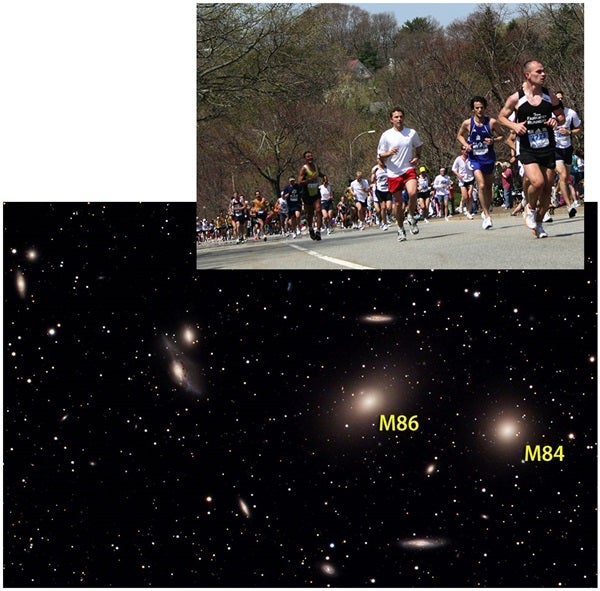1. Training: The Boston Marathon requires one obvious skill — long-distance running (a grueling 26.2 miles [42.2 kilometers] in this case). I’d been a recreational jogger for about two years before deciding to tackle my first marathon. Because I was in a condition to run 3 to 5 miles (5 to 8 km) daily without discomfort, I gradually added a series of relaxed weekend jogs covering successively longer distances until I was able to handle a nonstop run of more than 20 miles (32km).
The pathway to the Messier Marathon begins with competence in the use of your observing equipment and a familiarity with the night sky — skills I had attained through years of backyard astronomy. Even then, I didn’t consider attempting a Messier Marathon until I could locate a fair number of Messier objects from memory and quickly find the rest with a chart.
2. The start: In Hopkinton, Massachusetts (the traditional starting location of the Boston Marathon), and in a field in Westford, Massachusetts (a dark observing spot), I experienced the same pre-marathon jitters. Could I handle the challenge that lay ahead?
As the starter’s gun went off in Hopkinton, the marathoners dashed to the front to prevent other runners from boxing them in. But there was no starter’s gun in Westford — just sunset and gathering darkness. A “sprint out of the gate” was also necessary here, but in this case it was to capture the Messier objects rapidly setting in the west.
3. Body of the marathon: Some 3 miles into the Boston Marathon, I settled into a steady, relaxed rhythm that would carry me through much of the course. At this pace, I actually could look around and enjoy the scenery. The same held true for the Messier Marathon. The early evening frenzy behind me, I slowed down and began a leisurely stroll through many of Messier’s masterpieces.
One of the most notorious challenges in the Boston Marathon is “Heartbreak Hill,” the last of a series of hills encompassing miles 16 to 21. The Messier Marathon equivalent of Heartbreak Hill is the Coma-Virgo cluster — a confusing tangle of galaxies on the border of these two constellations. Each marathon challenge is negotiable, but the pace slows to a crawl. Knowing what to expect and being ready, I navigated both successfully. Heartbreak Hill and the Coma-Virgo cluster left me exhausted but determined to make it to the finish.
I completed the Boston Marathon in 4 hours, 55 minutes. My first Messier Marathon tally was 99 out of 109. It didn’t matter that these were somewhat modest figures. What counted is that I had gone the distance in both. The elation I felt upon completing each marathon overshadowed the inevitable exhaustion.
So, back to the original question: Which is the sterner physical and mental challenge, the Messier Marathon or the Boston Marathon? Each involves a fast start preceding a steady pace, and then a late-stage challenge before a furious dash to the finish. Both are tests of will and endurance requiring years of groundwork and preparation. The Boston Marathon may be more intense physically, but the Messier Marathon is an all-night struggle against sleep deprivation. My verdict? The two are equally challenging!
But don’t let this narrative discourage you from attempting a Messier Marathon. It’s a challenge that every dedicated backyard astronomer should try at least once. In the running world, individuals not ready to take on a full-fledged marathon often test the waters with a standard 5-kilometer (3.1 miles) race. In the March 2007 issue of Astronomy magazine, I outlined a Messier 5K as a beginner’s alternative to the Messier Marathon. The prime date for this year’s Messier Marathon (and its 5K) is Saturday, March 24. Are you up to the challenge?
Questions, comments, or suggestions? Email me at gchaple@hotmail.com. Next month: We celebrate Astronomy Day. Clear skies!











